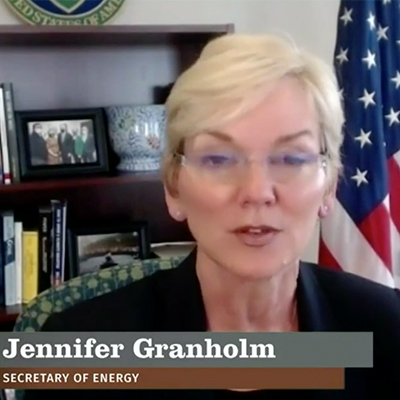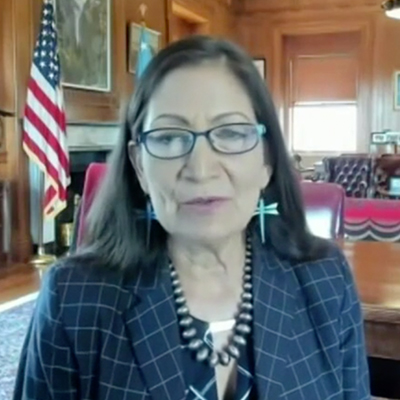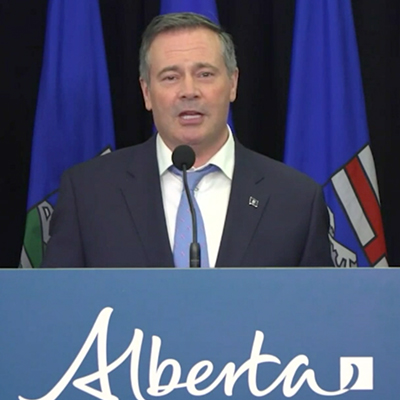The Biden administration wants the U.S. to dominate the global market for clean energy technologies, part of an effort to rebuild the economy, address climate change and counter China’s growing success in energy manufacturing, Energy Secretary Jennifer Granholm said last week.
“The global market for clean energy technologies is going to skyrocket to $23 trillion at a minimum by the end of this decade, and this administration on the federal level wants America to corner that market. We want to see those investments in every pocket of the country,” Granholm said Wednesday during the virtual annual meeting of the Western Governors’ Association.

The former Michigan governor said the administration has set goals to cut solar costs in half, reduce the cost of green hydrogen by 80% and develop a domestic supply chain for batteries while boosting the country’s electric vehicle industry. (See Hydrogen May Hold Key Role in Deep Decarbonization, EPRI Panel Says.)
Granholm said also that Biden has directed the Department of Interior to open up some federal lands for renewable development and “sustainable” extraction of minerals needed to supply the battery industry. About 47% of Western land is owned by the federal government.
“Know that this administration is committed to being independent of our economic adversaries who have had a five-year plan — China — to corner the market on these critical minerals,” she said. “We should be developing them, we should be recycling them, we should be looking from a research perspective at substitutes. But we’re not going to be able to do this unless we have some of our own supply.”
The WGA meeting brought together a handful of Biden administration officials with Western governors to discuss the most pressing issues facing the region. Following is more of what we heard at the event.
Drought, Wildfires
Speaking of the growing danger of wildfires in the West, Colorado Gov. Jared Polis said the term “fire season doesn’t even capture it because it’s a lot longer than it used to be.”
Through the U.S. Forest Service and Bureau of Land Management, the federal government owns about 40% of Colorado land, requiring a shared responsibility for wildfire prevention, Polis said. “And the states really need the federal government to step up big on forest health, fire mitigation.”
North Dakota Gov. Doug Burgum said the period from last fall through this past spring was the driest on record for his state, adding that the majority of the state is either in “extraordinary or extreme drought.” That has led to at least 1,000 grassland wildfires so far this year, including one of the most severe in state history. “We had our first fire this year in January,” he said. “That’s never happened before.”
“We all know that we’ve got to significantly upscale our preparation efforts in terms of our equipment and capacity to beat these fires,“ Agriculture Secretary Tom Vilsack, whose agency oversees the USFS, said Thursday. “That requires significant resources [included in Biden’s] American Jobs Plan. It does provide a significant amount of investment in what we refer to as green infrastructure that will enable us to do a much, much better and much more accelerated [hiring], which over time could minimize the risk of these horrific forest fires.”

“Where there is drought there is a greater risk of wildfire,” Interior Secretary Deb Haaland said, adding that she and Vilsack received a briefing in May by fire experts predicting a “very tough” fire season ahead.
“Quite frankly, wildfire has not always received the attention and resources that it deserves,” Haaland said. “The president’s budget reflects increases that demonstrate how seriously we take this issue, including providing a $100 million increase for fuels management and burned area rehabilitation work. In total, the budget proposal contains $1.1 billion for Interior’s wildland fire management program, as well as increases in funding for drought mitigation and science-based investments that will help the department and communities prepare for and address the aftermath of natural hazard events.”
Carbon Sink
Burgum touted his oil-producing state’s recently set goal of becoming carbon neutral by 2030 by using what he called its “geological jackpot.”
“And part of how we can do that is utilizing the incredible carbon sink capabilities we have in all of our ranch land and our farmland,” Burgum told Granholm on Wednesday. With North Dakota’s geology, he said, “we’ve got an opportunity to sequester and store 50 years’ worth of the nation’s CO2.”
Speaking to Agriculture Secretary Vilsack on Thursday, Burgum detailed his plans for all that sequestered CO2, saying North Dakota has a “big opportunity” to use geothermal or the heat produced by industry to use greenhouse technology to double its growing season to 12 months a year. Those indoor crops would “be enhanced by a pure stream of CO2,” which research has shown can increase crop yields.
“And then we can of course, as you know, transfer that CO2, turn it back into oxygen. Plants love doing that,” Burgum said. “That’s what they do for a living.”
Burgum told Vilsack that his state wants to continue to collaborate with the USDA on opportunities for farmers and ranchers to get paid for “smart” soil management practices that enable their lands to function as carbon sinks.
“I couldn’t agree with you more on the carbon opportunity, and we’re essentially establishing a variety of ways in which farmers and producers will be able to potentially benefit,” Vilsack said. “We want to make sure that as we do this, the programs we design are designed specifically for farmers, ranchers and producers [and] are not designed for somebody else outside of agriculture, [and] that they’re structured in a way that would allow even the smallest producer to participate.”
‘Just Transition’
Commerce Secretary Gina Raimondo said the transition to renewables must happen as quickly as possible because “climate change is here and unforgiving.”
“But it has to be a just transition. And that means providing significant support to folks who will be displaced. That means guaranteeing them that we’re going to be there for them to help find them another job and giving them the job training necessary,” Raimondo said, plugging the Biden administration’s $1.7 trillion American Jobs Plan.
“The truth is, there will be many jobs created in the move towards a cleaner energy future in solar, wind, battery, electric vehicles — all good jobs. But folks have to be trained to do those jobs,” she said. “And we have to make sure that those jobs are in our communities.”
Developments North of the Border
Alberta Premier Jason Kenney said in the past year his oil-dependent Canadian province endured a “triple black swan event” with the pandemic, global economic contraction and “absolute collapse” in energy prices, as oil prices fell from $60/barrel in February 2020 to less than $20/barrel for a short time last April.

Kenney said the U.S. gets about 60% of its oil imports from Canada, most of which comes from Alberta, where producers have cut their carbon intensity by 21% over the past 10 years and are “on track” for another 23% reduction in the next decade.
“They’re committed to achieving net zero greenhouse gas emissions from their operations by 2050. So our energy, we believe, is produced at the highest environmental human rights and labor standards, and we’re doubling down to advance Alberta’s position as a leader in environmental, social and governance outcomes,” Kenney said.
Alberta is also seeking to diversify its energy economy, with plans to use its natural gas reserves to develop a hydrogen sector. In May, Suncor and ATCO announced a project to develop about 300,000 tons of “clean” hydrogen a year in the province using a process to capture 90% of emissions generated during production.
“Alberta is also making great strides in renewables,” Kenney said. “The province’s electricity market has drawn more than $2 billion worth of investment in the last couple of years. And we’ve got a new framework in place to promote renewable energy storage and generation with zero subsidies from taxpayers.”


